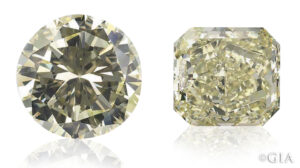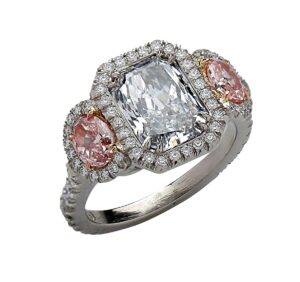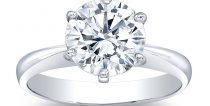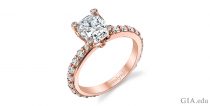With the variety of diamond cuts available, it can be a challenge to select just the right one. In fact, you might even want to create your own unique style by combining two or more diamond shapes or cuts together in one engagement ring or piece of jewelry for a design that stands out from the others. Perhaps diamond cutters were thinking along similar lines when they combined cutting styles to create something new and unique – calling the result a radiant cut diamond.
How do you know if the radiant cut diamond is for you? For those who appreciate the outline of an emerald cut diamond, but prefer the sparkle of a brilliant cut diamond, the mixed cutting style of the radiant cut may be a great option.

Notice the characteristics of the radiant cut: a square or rectangular mixed cut with cut corners. Photo: Robert Weldon/GIA.
What Is a Radiant Cut?
A radiant cut diamond has an eight-sided outline, and is typically square or rectangular in shape with cut corners. Now branded as The Original Radiant Cut, this diamond cutting style was patented in the late 1970s by Henry Grossbard, but others have since replicated the style after the patent lapsed.
The radiant cut is a mix of step cut facets on the crown and brilliant cut facets on the pavilion. Its angular shape and brilliant cut facets make it an alternative to either the round brilliant cut or the emerald cut. Unlike the emerald cut which favors diamonds of exceptional clarity, a radiant cut diamond can be more forgiving of inclusions.
Like other modified brilliant cuts, the radiant cut has the remarkable ability to transform a diamond’s color appearance, making the color appear either lighter or darker when viewed from above. Sometimes a colored diamond will be recut into a radiant to improve its face-up color.

This 6+ ct round brilliant cut diamond (left) was recut to a 4.61 ct radiant (right) to improve the appearance of its yellow color. Photo Elizabeth Schrader/GIA. Courtesy: the Scarselli family.
As you can see in the image above, this yellow diamond on the left was originally a round brilliant cut diamond weighing over 6 ct, which was graded in the W-X range of the GIA D-to-Z color scale. The stone was recut into the 4.61 ct radiant cut on the right and was subsequently graded Fancy yellow. You can clearly see the difference in color between the two.
What to Look for in a Radiant Cut Diamond
Look for a diamond with a centered culet , and parallel sides. Avoid corners that are uneven – either too wide, or too narrow. The proportions of radiant cuts, like other fancy shapes, can vary considerably. However, GIA research on the cut qualities of round brilliant cut diamonds indicates that there are many different combinations of proportions that can yield a brilliant diamond, and this is certainly true for fancy shapes, too. As for all diamonds, be sure to see the diamond in person to make sure it’s look appeals to you.
What Are Popular Setting Styles for Radiant Cuts?

Side stones can be a stylish complement to a radiant cut stone. This Fancy Yellow radiant cut center diamond is flanked with two trilliant cut diamonds as side stones. Photo: Joel Beeson/GIA
Often the radiant cut is mounted in a prong setting. The radiant cut makes for a great solitaire that shows off the diamond’s distinct cut. Some choose to complement the radiant cut with side stones – trilliant or rectangular shaped stones are often used. If you’re a fan of the tennis star Anna Kournikova, you may have noticed her yellow radiant cut diamond engagement ring that is accented with two colorless trillion cut diamonds.
The trend of halo settings has not been overlooked by fans of the radiant cut. You may have also admired celebrity Megan Fox’s radiant cut engagement ring in a halo setting, for example.
Does the radiant cut strike your fancy? Leave us a comment and let us know how you like it.








